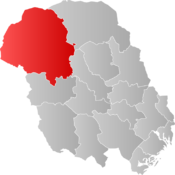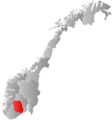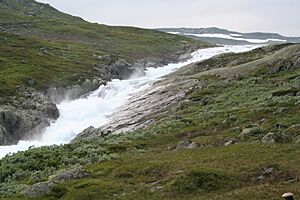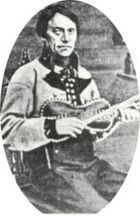Vinje facts for kids
Quick facts for kids
Vinje kommune
|
|||
|---|---|---|---|
|
Municipality
|
|||
 |
|||
|
|||

Vinje within Telemark
|
|||
| Country | Norway | ||
| County | Telemark | ||
| District | Vest-Telemark | ||
| Established | 1 Jan 1838 | ||
| Administrative centre | Åmot | ||
| Area | |||
| • Total | 3,105.83 km2 (1,199.17 sq mi) | ||
| • Land | 2,724.86 km2 (1,052.07 sq mi) | ||
| • Water | 380.98 km2 (147.10 sq mi) 12.3% | ||
| Area rank | #14 in Norway | ||
| Population
(2023)
|
|||
| • Total | 3,832 | ||
| • Rank | #209 in Norway | ||
| • Density | 1.4/km2 (4/sq mi) | ||
| • Change (10 years) | 3% | ||
| Demonym(s) | Vinbygg Vinbygge (male) Vinbyggje (female) |
||
| Time zone | UTC+01:00 (CET) | ||
| • Summer (DST) | UTC+02:00 (CEST) | ||
| ISO 3166 code | NO-4036 | ||
| Official language form | Nynorsk | ||
| Created as | Formannskapsdistrikt in 1838 | ||
|
|
|||
Vinje is a municipality in Telemark county, Norway. It is located in the traditional district of Vest-Telemark which is part of Øvre Telemark. The administrative centre of the municipality is the village of Åmot. Other villages in the municipality include Arabygdi, Edland, Grunge, Haukeli, Krossen, Møsstrond, Nesland, Øyfjell, Raulandsgrend, and Vinje.
The 3,106-square-kilometre (1,199 sq mi) municipality is the 14th largest by area out of the 356 municipalities in Norway. Vinje is the 209th most populous municipality in Norway with a population of 3,832. The municipality's population density is 1.4 inhabitants per square kilometre (3.6/sq mi) and its population has increased by 3% over the previous 10-year period.
Contents
General information
The parish of Vinje was established as a municipality on 1 January 1838 (see formannskapsdistrikt law). In 1860, the northern district of Vinje (population: 745) and the Øyfjell area of Lårdal (population: 243) were combined to form the new municipality of Rauland. During the 1960s, there were many municipal mergers across Norway due to the work of the Schei Committee. On 1 January 1964, Rauland municipality (population: 1,656) and Vinje municipality (population: 2,565) were merged to form a new, larger Vinje municipality.
Name
The municipality (originally the parish) is named after the old Vinje farm (Old Norse: Vinjar) since the first Vinje Church was built there. The name is the plural form of the word vin which means "meadow" or "pasture".
Coat of arms
The coat of arms was granted on 16 November 1990. The official blazon is "Azure a billy goat argent" (Norwegian: På blå grunn ein sølv geitebukk). This means the arms have a blue field (background) and the charge is a billy goat. The billy goat has a tincture of argent which means it is commonly colored white, but if it is made out of metal, then silver is used. The color blue and the goat were chosen based on an old poem written by Aasmund Olavsson Vinje. The poem is called Blåmann (lit. blue man) which is about a goat named Blåmann. This was also chosen to represent the importance of sheep and goat farming in the mountainous municipality. The arms were designed by Arvid Sveen. The municipal flag has the same design as the coat of arms.
Churches
The Church of Norway has four parishes (sokn) within the municipality of Vinje. It is part of the Øvre Telemark prosti (deanery) in the Diocese of Agder og Telemark.
| Parish (sokn) | Church name | Location of the church | Year built |
|---|---|---|---|
| Grungedal | Grunge Church | Grunge | 1850 |
| Rauland | Møsstrond Church | Møsstrond | 1923 |
| Rauland Church | Raulandsgrend | 1803 | |
| Vinje og Nesland | Nesland Church | Nesland | 1847 |
| Vinje Church | Vinje | 1796 | |
| Øyfjell | Øyfjell Church | Øyfjell | 1833 |
History
The longstanding local traditions of arts and crafts have been well maintained. Rauland hosts a national academy for arts, crafts, and traditional music. Folk music has always been strong in Vinje. The Myllarguten, Targjei Augundsson lived the last years of his life in Rauland. Vinje has also been home to many rosemåling artists.
Vinje became a site of heavy battles during World War II, at the Battle of Vinjesvingen when Norwegian forces held out for over a month against superior German forces.
Geography
Vinje is situated on both the Hardangervidda plateau and parts of the Setesdalsheiene mountain plateau. Most of the land area of the municipality is quite high in elevation. The European route E134 highway passes through Vinje on its way over the mountain pass to connect Eastern Norway and Western Norway. Vinje sits along the highway about halfway between Oslo (in the east) and Haugesund (on Norway's west coast). Starting at Haukeli, the Norwegian National Road 9 leads up the steep slopes to Hovden and further south down the Setesdal valley to the southern coastal city of Kristiansand.
The mountain ski resort Haukelifjell is also found nearby. The isolated and sparsely populated area is known for its rugged, mountainous terrain that supports a wide variety of outdoor activities, amongst them hiking, mountain biking, snowboarding, skiing, fishing, and canoeing. The Hardangervidda National Park lies partially in western Vinje. The village of Arabygdi lies on the lake Totak in the western part of Rauland. Its famous attraction is the "Urdbøuri", the largest stone scree in Northern Europe, with huge boulders scattered on the floor of the valley.
The rivers Tokke and Vinjeåi both flow through the municipality. The lakes Holmavatnet, Møsvatn, Songavatnet, Totak, and Vinjevatn are all located in Vinje as well. The mountains Fitjanuten, Kistenuten, and Vassdalseggi all lie on the municipal and county border in western Vinje.
Notable people
The Arts
- Sveinung Svalastoga (1772 in Rauland – 1809), a rosemåling painter, poet, and woodcarver
- Myllarguten (Torgeir Agundson Øygarden) (1801–1872), a folk musician and master fiddler
- Aasmund Olavsson Vinje (1818–1870), a poet and journalist who used Nynorsk
- Rikard Berge (1881 in Rauland – 1969), a folklorist, museologist, biographer, and editor
- Tarjei Vesaas (1897–1970), a poet and novelist
- Aslaug Vaa (1889 in Rauland – 1965), a poet and playwright
- Aslak Brekke (1901–1978), a vocalist using stev and a folk singer
- Dyre Vaa (1903–1980), a sculptor and painter whose works are found in Oslo and Vinje
- Anne Lofthus (1932–2003), a ceramic artist and art teacher
- Guri Vesaas (born 1939), a writer and translator of children's books
- Stein Versto (born 1957), a poet, novelist, translator, and folk musician
- Aasmund Nordstoga (born 1964), a musician, singer, composer, and TV presenter
- Sven Erik Kristiansen (born 1969), a musician and former vocalist in the black metal band Mayhem
- Arve Moen Bergset (born 1972), a traditional folk singer, hardanger fiddler, and classical violinist
- Odd Nordstoga (born 1972), a folk singer, musician, actor and editor
- Ingebjørg Bratland (born 1990), a folk singer, kveder, and artist
Public Service
- Paul Peterson Paus (1625-1682), a cleric, political activist, and poet
- Olav Aslakson Versto (1892 in Rauland – 1977), a politician
- Einar Skinnarland (1918–2002), a Norwegian resistance fighter during WWII and dam builder
- Aslak Versto (1924-1992), a politician
- Olav Vesaas (born 1935), a journalist, biographer, and publisher
- Olav Versto (1950–2011), a journalist and editor
- Astrid Versto (born 1953), a journalist and diplomat
Sport
- Olav Jenssen (born 1962), a discus thrower who competed in the 1992 Summer Olympics
- Knut Tore Apeland (born 1968), a former Nordic combined skier and two-time team silver medallist at the 1992 & 1994 Winter Olympics
- Terje Håkonsen (born 1974), a snowboarder
Attractions
- The home of Myllarguten is now a small museum. (The cotters place Kosi in Arabygdi.)
- The monument of Myllarguten, the 19th century musician, who played for kings and who inspired Edvard Grieg . It is located on the roadside vis-a-vis Kosi.
See also
 In Spanish: Vinje para niños
In Spanish: Vinje para niños







